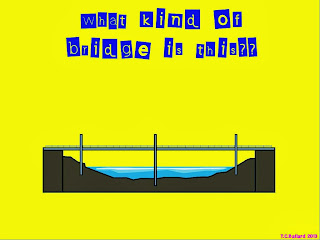Sooooo, you've been tasked with teaching your little friends about forces and motion, and you're trying to figure out how to tie all of the measured concepts together into something relevant AND fun...have them relate forces and motion to bridges!! :) I begin each and every one of my lessons with some form of inquiry, whether it's a STEM related lesson or not. I always ask my friends "Why?" first before we learn about theories, laws and ideologies...No I don't teach college students, I teach third grade. :) Professional and scholarly research supports this type of model as a great way to initiate and foster learning, so why not??

After allowing them to share with their friends their ideas on why we have bridges, I show them the parts of a typical bridge. I don't however, tell them why each bridge part is necessary...I let them come to their own realizations as to why, first alone, then with their groups...and then as a class. We arrive at all conclusions as a class!!
Then we discuss the most common types of bridges there are. We discuss arch bridges, suspension bridges and beam bridges. Again I challenge my students to differentiate between bridge types and possible reasons to use one bridge design as opposed to another. The next few graphics show the progression of the lesson.
I then present my friends with scenarios and challenges...aka Laboratories that require them to use their science and mathematical knowledge to engineer examples of technology. In this case I have challenged my friends with devising a bridge design that will hold a moving toy car, the catch is that the car cannot be pushed or pulled by human hands, requiring students to come up with other ways to move the toy car. I have them test materials that could be used in their designs before they actually begin any constructing. This gives them an opportunity to brainstorm and make conclusions on which of the given materials would provide the least and the most amount of friction, it will also allow them to work with balancing objects and adding necessary supports. Then I have them redesign their bridges, during this stage however, I asked that they make the car reach the other side in as slowly a time as possible.
And that's how you do it!!
Oh, if you have a whiteboard and use the software ActivInspire, here's a link to download the entire flipchart, if not, you can use the links below to facilitate the lab discussed above, complete with directions for your students and data collection space. Have fun! Have STEM!










No comments:
Post a Comment